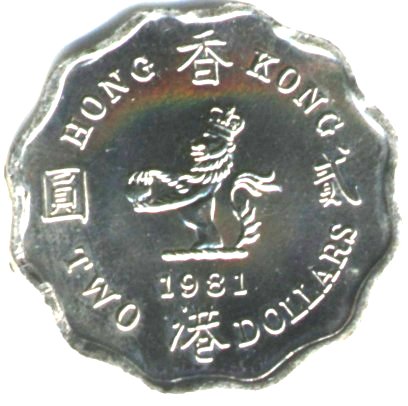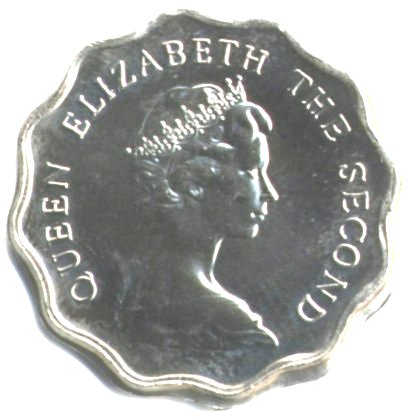





Hong Kong 1981 Two Dollars
Level partial collar strike (top die: reverse; bottom die: obverse)
Weight : 8.4 grams
In addition to the reverse & obverse dies, there is a third die called the collar die. The collar prevents the planchet (blank) from spreading when struck by the top & bottom dies, and therefore, provides the edge. The collar is a round piece of solid steel with the center machined out to the shape of the final coin. The collar is wider (thicker) than the thickness of the planchet. The minting press feeds the planchet over the collar & the planchet falls into the collar and rests on the bottom die. After the planchet is struck, the finished coin cannot be removed except by the lower die pushing it up out of the collar.
The collar die is not fixed. It rests on springs to enable it to move in order to prevent damage to it in the event that the top die hits it due to a malfunction. Sometimes, the collar becomes stuck in a position other than the correct one due to debris (metal, grease, etc.) getting in between it and the lower die. When the collar is stuck in a position parallel to (even with) the lower die and partly below the lower die, the edge of the planchet will not be completely covered by the collar. In such a case, after strike, a portion of the planchet's edge will be spread over the collar (not struck)and a portion will be struck by the collar. This error type is called a "level partial collar strike" . The spread, or restricted by collar, portion will be the same amount all around the edge of the coin. When the collar is stuck in a tilted position (at an angle to the lower die), the error type is called a "tilted partial collar strike". The spread, or restricted portion, will be wide at one point on the edge and then gradually become narrower or normal at the opposite edge. The side of the coin that shows the spread part of the planchet identifies the top die. The restricted (or "in collar") portion identifies the bottom die. This coin appears to be a tilted partial collar with the reverse as the top die and obverse as the bottom die.
{Thanks to Mr. Robert Kril for providing the descriptions}
Click Here to See Other Error Coins ..Click Here to See Other Hong Kong Coins
Click Here to See Other Hong Kong Coins
Click Here to Go Back to Homepage
¡@